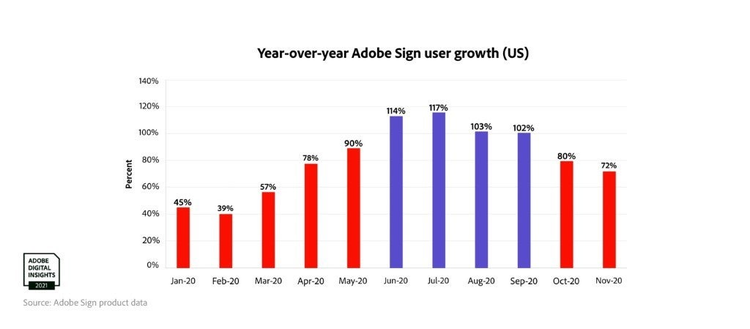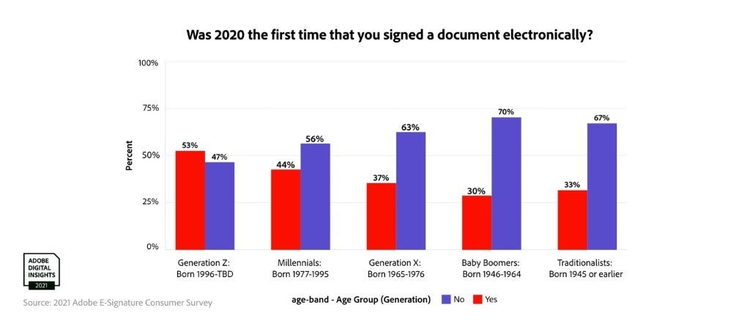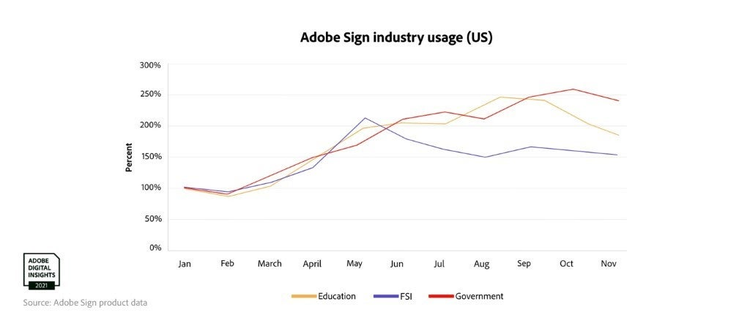Adobe Digital Insights: Top 3 consumer trends shaping e-Signatures and how we will work in 2021
The Adobe Digital Insights team surveyed 4,000 consumers worldwide about how they used e-signatures as they go contact-free in all aspects of their lives during COVID.

The pandemic has changed everyone’s lives. At Adobe, we saw this in many forms, as working from home and video conferencing became the new norm. For our business, one of the most pronounced changes has been the acceleration of e-signatures, part of our Document Cloud offering.
It’s in that business that we saw big shifts last year in everyone’s desires to be even more productive using digital documents and e-signatures, especially as most of us continue to shelter-in-place and work remotely. 2020 turbocharged the paper-to-digital transition, especially among younger people who e-signed for the first time, and there’s no going back in the year ahead.
The Adobe Digital Insights team surveyed 4,000 consumers worldwide about how they used e-signatures as they aimed to go contact-free in all aspects of their lives during COVID. We also pulled 2020 usage data from Adobe Sign, which makes signing and sending documents for e-signature easier. The key takeaways: contact-free signatures are having a big moment, young people are e-signing in droves, and businesses turned from paper-based to digital in record time. Let’s dig in.
E-signatures go mainstream
The pandemic exposed an inconvenient truth: juggling paper documents is cumbersome and antiquated. As a result, e-signatures and digital document use grew exponentially last year. Overall, 60 percent of consumers signed more digital documents in the past six months than the previous six, and Adobe Sign witnessed triple-digit year-over-year growth in users each month from June through September 2020.

The shift from paper to digital has been happening since PDF was introduced — yet a surprising number of American consumers hadn’t e-signed a document before 2020. More than a quarter (27 percent) of Americans electronically signed a document for the first time last year. These include critical documents across different industries such as business contracts, healthcare registration forms, loan agreements, employment contracts, and parental consent forms.
And there’s more to the story. The pandemic has pushed more than a third (38 percent) of Americans to turn to the cloud. The ability to store, manage and act on documents in the cloud makes it simpler to be productive in this new world. This could mean more safely and efficiently checking in for a doctor appointment, managing tax returns remotely with CPAs, or registering for classes as schools go virtual.
Young consumers are key to growth
In 2020, young consumers drove a lot of the growth in digital documents and e-signatures. Nearly half of Gen Z (53 percent) said that 2020 was the first time they signed a document electronically, compared to only 30 percent of Baby Boomers. As they enter adulthood, an overwhelming majority (79 percent) of Gen Z didn’t know e-signatures even existed and never had a chance to sign documents digitally before last year.
About half of Gen Z and millennials increased their use of digital documents last year, compared to less than a third of Baby Boomers. A significant majority (73 percent) of these younger consumers relied more on smart devices to sign documents compared to just over a quarter of Baby Boomers. Over a majority of Gen Z and Baby Boomers still prefer the use of desktop or laptop computers to e-sign.

Triple-digit growth: Key industries embrace the future of work
The pandemic accelerated the digital transformation in government, financial services and education, as customers, citizens and students looked for more efficient ways to get things done.
Traditionally, schools have relied heavily on paper, but the pandemic proved to be a forcing function to use digital documents and e-signatures for critical tasks like school operations. This includes standard workflows for grants and donations, student services, admissions, financial aid, class registrations benefits, payroll and IT. As a result, there was a sharp rise in e-signatures in the education sector between August and September (250 percent year over year). Similarly, there was a triple digit rise in e-signatures in the financial services sector in May (over 200 percent year over year).

Younger consumers were also a driving force behind the rise in e-signatures in the financial services industry. 80 percent of Gen Z and Millennials worldwide signed financial documents, such as opening a bank account, loan agreement, investment, wealth management, mortgage agreements in the past year.
More than 63 percent of Americans want government agencies like the DMV and immigration to provide more e-signature support for critical documents. While the increased use of Adobe Sign in government wasn’t as dramatic a spike as in financial services, agencies saw a gradual increase during the Spring.
The path forward
Once the pandemic fades into history, we believe that many of the digital changes it introduced and accelerated will remain. We project that an overwhelming majority (76 percent) of consumers worldwide will continue to e-sign documents post pandemic.
Yet there are still opportunities to innovate how consumers manage and sign digital documents. More than 63 percent of Americans now believe that companies lacking e-signature options are behind in the times. And, globally, fewer than 47 percent of survey respondents believe that e-signature technology is advanced today.
As we get closer to the light at the end of the tunnel, consumers worldwide likely won’t go back to manual ways of managing and signing documents. E-signatures have become the standard and there’s now a big expectation that this technology is here to stay.